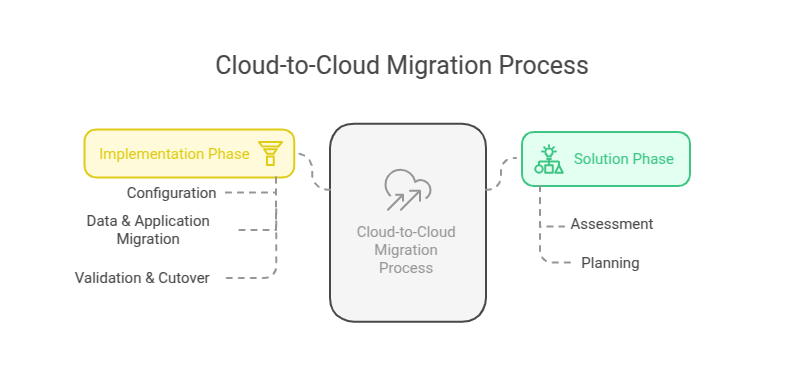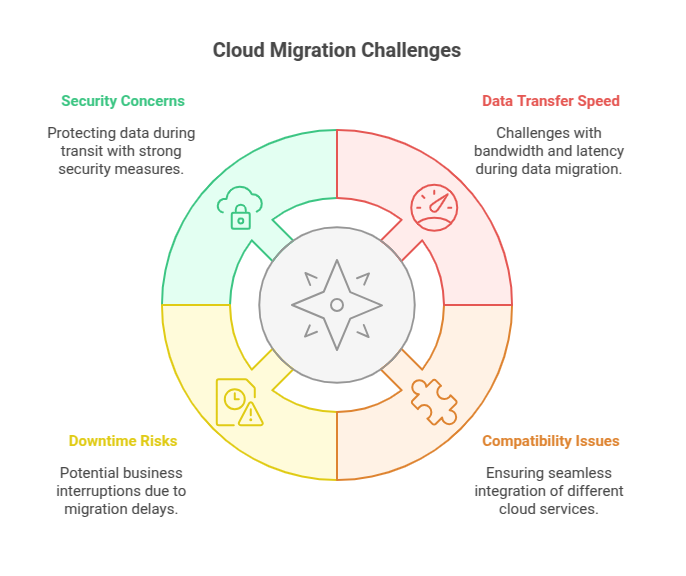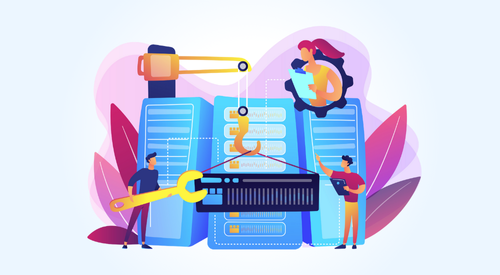

Gartner predicts that by 2026, 75% of organizations will adopt a cloud-first strategy. The rapid rise of cloud computing has changed how businesses manage digital assets. Digital-first companies are increasingly looking to cloud-native solutions for growth, efficiency, and lower costs. Yet, as cloud ecosystems continue to grow and evolve, organizations find themselves needing to move workloads from one cloud provider to another in an attempt to improve flexibility and performance or meet compliance. In this blog, we explore the significance of cloud-to-cloud migration for digital native accounts, the key challenges involved, and the best practices to ensure a seamless transition.
Make a Seamless Transition to a More Scalable Cloud Architecture
As cloud technology matures, businesses will increasingly need to engage in ongoing evaluations of their digital positioning to stay competitive and engaged in an emerging networked ecosystem. The shift to adopting cloud-agnostic architectures, as well as open-source technology, allows for improved portability and less dependence on specific vendors. This will ultimately lead to more sustainable outcomes for an organization, which allows organizations to easily shift in response to cloud innovations and/or changing market conditions well into the future.
The Rise of Digital Native Accounts
Digital Native organizations, unlike traditional organizations, have built their processes/operations using cloud and digital technology from the get-go. These organizations have leveraged cloud-native architectures from the ground up. In contrast, traditional enterprises are those that have transitioned from on-premise systems to the cloud, having begun their business on legacy technology. Digital natives often utilize cloud-native offerings, such as Kubernetes, serverless, AI-empowered analytics, etc.
Digital Native Accounts are cloud-based accounts that are created and exist entirely in the cloud (e.g., Google Cloud). Unlike traditional accounts that have been migrated from on-premise systems, digital native accounts are created without dependency on legacy systems, managing data, applications, and services in the cloud and independent of legacy infrastructure. Digital Native Accounts leverage cloud-native capabilities such as managed databases, microservices, and AI-based analytics to enable organizations to scale without compromise, optimize performance, and innovate without the restrictions of traditional IT departments.
The agility of Digital Native Accounts allows companies to adapt rapidly to changes in technology. Because they do not rely on legacy infrastructure, digital natives can more easily experiment with new cloud technologies, use DevOps extensively, and implement CI/CD pipelines. This agility allows digital-native companies to stay a step ahead of competitors and quickly respond to market demands.
Why is Cloud-to-Cloud Migration Important
Cloud-native businesses often move their accounts to different cloud providers as they expand and grow in their cloud maturity. Smooth migration approaches become necessary as cost management, compliance, and vendor diversity demand better service with zero disruptions while maintaining operational efficiency.
Cloud-to-cloud migration is driven by several key factors, including:
- Vendor Lock-in Issues & Multi-Cloud Strategies: Often, companies begin their journey with one cloud provider, only to find that a multi-cloud or hybrid-cloud strategy is necessary to prevent lock-in with a single vendor. Either moving to another cloud or creating redundancy across different clouds creates a better level of flexibility and resilience.
- Cost Optimization & Performance Improvements: The pricing models, along with the performance characteristics of the cloud platform, differ from one to another. Moving to a less expensive or more high-performing cloud service provider leads to increased return on investment (ROI) together with system performance improvement.
- Business Continuity & Disaster Recovery: Maintaining a reliable disaster recovery (DR) strategy typically involves spreading workloads and digital presence among multiple clouds, assuring that critical services can run without interruptions during outages or breaches.

Image 1: Cloud-to-Cloud Migration: The Process
Cloud-to-Cloud Migration: The Process
A structured approach to migration ensures a smooth transition between cloud platforms. The key steps include:
The Solution Phase
1. Assessment
- Inventory of cloud assets and dependencies.
- The team runs an Inventory script on the client’s environment for details of the existing setup and understands the application flow via discovery calls with the client.
- Given the fast-paced nature of Digital Native accounts, inventory scripts are built for rapid discovery while also ensuring a thorough understanding of the existing setup.
2. Planning
- Mapping from source to target architecture.
- Equivalent architecture is built by the team after assessing the existing setup.
- Appropriate solutions for Application and Data migration are done, ensuring alignment with customer needs for a seamless migration.
Implementation Phase
1. Configuration
- Setting up of networking, security, and IAM is carried out.
- Landing Zone setup is done in the GCP environment by following best security practices tailored to customer requirements.
- Infrastructure setup is completed within the Landing Zone using Infrastructure as Code (IaC) tools like Terraform, ensuring rapid deployment and minimizing manual errors.
2. Data & Application Migration
- Data Migration: Transferring databases, storage, and files using appropriate cloud-native tools.
- Application Migration: Choosing between Re-hosting (Lift-and-Shift), Re-factoring, or re-architecting applications based on business needs.
3. Validation & Cutover
- Validation: Testing functionality and performance of migrated workloads to ensure all applications work as expected in the new environment.
- Cutover: Final switch to the new environment with minimal downtime, followed by continuous monitoring to ensure stability and performance post-migration.

Image 2: Cloud Migration Challenges
Challenges to Digital Natives
Despite its benefits, migrating digital native accounts comes with challenges:
- Data Transfer Speed & Latency Issues: Moving significant data amounts between cloud providers can put pressure on bandwidth. Thus, careful planning is necessary to prevent latency and interruption.
- Compatibility of Services & Configurations: Each cloud provider has unique APIs, services, and configurations. Thorough compatibility checks are required to ensure seamless application migration.
- Downtime Risks & Business Impact: Unanticipated downtime can interrupt business continuity. Using phased migration or hybrid deployments can reduce the amount of downtime experienced when migrating cloud apps.
- Security Concerns During Transit: Ensure that encryption, authentication, and secure API integrations are all parts of the deployment strategy before migrations begin. Also, strong security measures are necessary to help protect valuable data and applications from cyber threats.
Case Study
Bobble AI Migration to Google Cloud: Niveus Solutions helped Bobble AI migrate to Google Cloud to optimize costs and improve performance. The move resulted in scalability, better resource utilization, and great cost savings for Bobble AI. They improved their infrastructure by utilizing Google Cloud capabilities, which provided the potential for better efficiency and growth.
Zero Downtime Cloud Migration: Niveus Solutions executed a seamless cloud transition with no downtime for a leading financial/technology solutions provider. This enabled an uninterrupted business operation while improving flexibility, security, and cost savings. The transition utilized automation and best practices to minimize risk and drive efficiency.
Conclusion
For digital-native enterprises, migrating from one cloud to another is necessary for optimizing their costs, performance, and compliance as they work through evolving digital capabilities. Though there are challenges in the process, with the right planning and migration strategy, the result is worth it, bringing about minimal downtime, better productivity, and operational efficiency.
Niveus Solutions helps organizations successfully migrate from one cloud to another, with tailored strategies connected to organizational goals. Our knowledge of Landing Zones, Infrastructure as Code (IaC), data migration, and application modernization gives organizations the ability to pivot to an ascendant cloud configuration with certainty. Through the application of Google’s best practices, security frameworks, and automation practices, organizations can unleash agility, scalability, and success in their long-term cloud journey.











